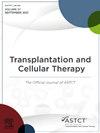Determinants of Immune Suppression Discontinuation in the Modern Era: A CIBMTR Analysis of 18,642 Subjects
IF 3.6
3区 医学
Q2 HEMATOLOGY
引用次数: 0
Abstract
The desired long-term outcome of allogeneic hematopoietic cell transplantation (HCT) is malignancy control, freedom from graft vs. host disease (GVHD), and durable discontinuation of immune suppression (IS). We previously examined IS discontinuation (ISD) in patients treated on BMT CTN 0201 and 0402 trials. In our current CIBMTR analysis, we aimed to study ISD in a more contemporary (HCT 2009-2019) and broadly representative cohort: We included subjects of all ages, conditioning intensity, graft source, donor type, and GVHD prevention approaches.
Using a multi-state model framework (health states including initial IS, acute GVHD, chronic GVHD, ISD, resumed IS for ISD failure, and absorbing state of death/relapse/second HCT), we studied the probability of ISD, and examined which baseline features were associated with ISD. Given the very large sample size, we developed and validated (against investigator review) an algorithm for identifying health state transitions from the primary data. The probability of being alive with ISD was estimated using logistic pseudo-value regression models. Comprehensive baseline patient, disease, and HCT variables were examined for association with ISD outcome, including testing for all interactions.
Among included subjects (N=18,642), major characteristics were the following: median age 52.8 years, male 58.6%, White 78.4%, AML/MDS 62.5%, DRI low/int 61.8% vs. high/very high 29.3%, varied donor types (matched sibling 25.8%, 8/8 matched unrelated donor (MUD) 40.5%, mismatched MUD 8.4%, haploidentical 11.5%), graft (marrow 16.4%, PBSC 69.9%, UCB 13.8%), MAC conditioning 62.5%, GVHD prophylaxis (PTCY+others 13.7%, TAC/MTX 42.3%, TAC/MMF 14.7%, TAC/other 6%, CSA/MTX 8%, CSA/MMF 10.2%, CSA/others 1%, others 4.1%), and ATG use in 27.2%. Median follow up time for survivors was 46.1 months.
ISD was achieved at any point for 37.1% of subjects, at a median of 6.8 months post-HCT. Median time to ISD differed by GVHD history: 5 months for no prior GVHD, 6 months for prior acute GVHD, and 20.6 months for prior chronic GVHD. ISD failure occurred in 27.5% (at a median of 4.9 months) of those who reached ISD, and only 22.7% of these ISD failures ever reached a second ISD in follow up. Only 15% of subjects were alive with ISD by 5 years from HCT. Baseline variables associated with ISD are presented in Figures 1 and 2. The impact of GVHD prevention approach on ISD outcome differed by patient age (Figure 3), while no other interactions were detected.
This study represents the largest and most comprehensive examination of the probability and determinants of ISD in the current era. Major applications include patient education on expected HCT outcomes, practical guidance for clinicians, and ISD benchmarks for clinical trial design. Development of dynamic prediction models (as done with our prior analysis) is underway to facilitate implementation of these findings at the point of care.
求助全文
约1分钟内获得全文
求助全文
来源期刊

Transplantation and Cellular Therapy
Medicine-Hematology
CiteScore
7.00
自引率
15.60%
发文量
1061
审稿时长
51 days
 求助内容:
求助内容: 应助结果提醒方式:
应助结果提醒方式:


